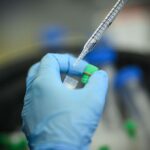In Grenoble in Isère, a research laboratory has just made an important discovery in the treatment of aggressive breast cancers. A protein, SMYD2, is in fact responsible for the development of metastases in the human body. After four years of work, this discovery could be used to identify treatments for this disease. Explanations with Nicolas Reynoird, researcher at the CNRS.
After four years of work, the Institute for the Advancement of Biosciences (IAB), a research laboratory in Grenoble, arrived at an unprecedented discovery: that of the properties of a protein responsible for the development of metastases in people suffering from breast cancer. Explanations with Nicolas Reynoird, researcher at the CNRS and member of the IAB.
France 3 Alpes: What is the SMYD2 protein, the properties of which you have managed to identify?
Nicolas Reynoird, researcher at CNRS: In the laboratory, we work on intracellular signaling, all the mechanisms that occur in cells and which are deregulated in the case of cancers. We realized that the SMYD2 enzyme was present in very large quantities in breast cancers, without us really knowing what it did. SMYD2 is not normally present in the breast, so it assumes that cancer benefits from it. We said that by blocking SMYD2, we would reduce the growth of the main tumor. Well, that wasn’t the case at all, we were surprised.
France 3 Alpes: So what did you discover by preventing the action of SMYD2?
Nicolas Reynoird: To do this, we worked with American researchers, specialists in mouse models. These are mice genetically modified to mimic the development of breast cancer in humans.
After the identification of SMYD2, we will block the action of this enzyme in some of these mouse models. We could then see an almost complete loss of metastases and there was almost no colonization of other organs, such as the lungs or the brain. It is very often these metastases which make treatment almost impossible and cause the death of patients and not necessarily the primary tumor.
These mice had a better survival rate, with a lifespan extended by 20 to 25% after the initial stage of cancer development. Moreover, the Inhibitors that block SMYD2 have no side effects, they will not affect the normal functioning of non-cancerous cells.
France 3 Alpes: What is the mechanism of SMYD2?
Nicolas Reynoird: Cancer cells will use a very specific mechanism to colonize the body. Inside the cell, SMYD2 will stimulate another protein, responsible for cell adhesion and migration.
These will be able to create sort of suction cups and cling to other cells. A third type of protein, called FMNL, will detect this change and create protrusions, like a bump at the front of the cell, at the level of its membrane. This bump serves as a starting point for the cell, which will then be able to move forward. Cancer cells acquire an ability to move forward that they do not normally have. They will then come out of the main cancer to colonize the body.
France 3 Alpes: What will your discovery allow?
Nicolas Reynoird: The interest is not to cure breast cancer but to prevent the appearance of metastases, which is the most aggressive step. This may give the clinical team more time to find a better treatment for the main tumor.
There are still very few teams capable of identifying the substrates, the target proteins which will be modified by SMYD2. We will see what the exact impact will be on sensitivity to treatment, and target other players which may be other therapeutic targets, for example other enzymes which could have similar effects on cell migration. We may be able to develop inhibitors for other cancers.











